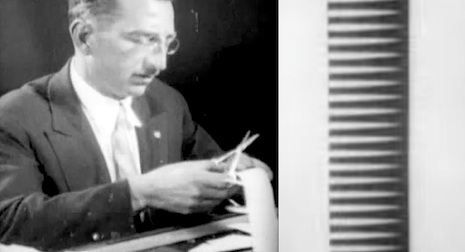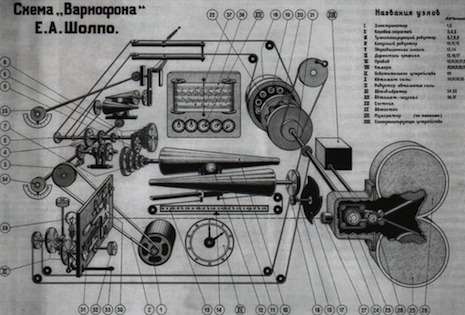
Sometime in the early 1920s the Bauhaus artist László Moholy-Nagy suggested that a new form of “music writing” could be created from the grooves in phonographic records. He believed experimenting with the groves would enable composers, musicians and artists to produce music without recording any instruments. Long before scratching, Moholy-Nagy also believed the phonograph could become “an overall instrument… which supersedes all instruments used so far.”
With the arrival of synchronized sound in movies, as seen and heard in the first talkie The Jazz Singer in 1927, Moholy-Nagy refined his idea believing a whole new world of abstract sound could be created from experimentation with the optical film sound track. He hoped such experimentation would “enrich the sphere of our aural experience,” by producing sounds that were “entirely unknown.”
In 1929, the Russians produced their first talkie, the snappily titled The Five Year Plan for Great Works. The possibility of synchronized sound inspired a trio of pioneers, composer Arseny Avraamov, animator Mikhail Tsihanovsky and engineer Evgeny Sholpo who were fascinated by the curved loops, arcs and waveforms on the optical soundtrack. The patterns made them wonder if synthetic music could be created by drawing directly onto the sound track. Of course, this they did, at first testing out vase-shapes and ellipses then Egyptian hieroglyphs—all with startling results.
In 1930, Avraamov produced (possibly) the first short film with a hand-drawn synthetic soundtrack.
An example of Avraamov’s early experimentation in ‘ornamental sound.’
Meanwhile back at the lab, Evgeny Sholpo was collaborating with composer Rimsky-Korsakov on building what was basically an “optical synthesiser” or Variophone that used an oscilloscope to cut waveforms on small paper discs to produce synthetic music (“ornamental sound”) that was synced to 35mm film, before being photographed onto the same film to create a continuous soundtrack. Kinda laborious, but neat, the end product sounding that sounded like the music to a 8-bit game cartridge.

Diagram of a Variophone
Sholpo with his Variophone in 1935—sadly no English subtitles, but watch and listen and you’ll get the idea.
Elsewhere, Nikolai Voinov was developing the idea of cutting paper to create a synthetic soundtrack—a technique that used “magnetic tape and an ultra-chromatic 48 tune microtonal system” which was produced by drawing on the magnetic tape. Voinov produced very basic short animations using this technique such as Rachmaninov Prelude (1932) and The Dance of the Crow (1933).
Voinov shows how to cut paper music.
In February 1936, Modern Mechanix Magazine reported on Voinov’s experiments:
Synthetic musical notes that can be filed away in a card index have been developed by a group of Soviet musicians and scientists. The hand-sketched notes, resembling combs, are used to produce musical accompaniment for motion picture films.
N. Voinov of Moscow sketched and cut out cardboard combs of the 80 semi-tones of the piano. By selecting the proper combs and photographing one after another in correct order on the sound track of a movie film, Voinov was able to produce any favorite piano melody.
E. Sholpo of Leningrad developed method of producing synthetic sound. Instead of sketching individual notes, he prepared disks with cut openings. The speed at which the disk is revolved when photographed determines the pitch of sound. Notes of a high pitch are produced by revolving the disk rapidly; low speeds produce low notes.

The Modern Mechanix report on Voinov.
Voinov and Avraamov briefly formed a research institute in Moscow, where they hoped to create synthetic voices and understand the musical language of geometric shapes. It didn’t last and, alas, closed within a year.